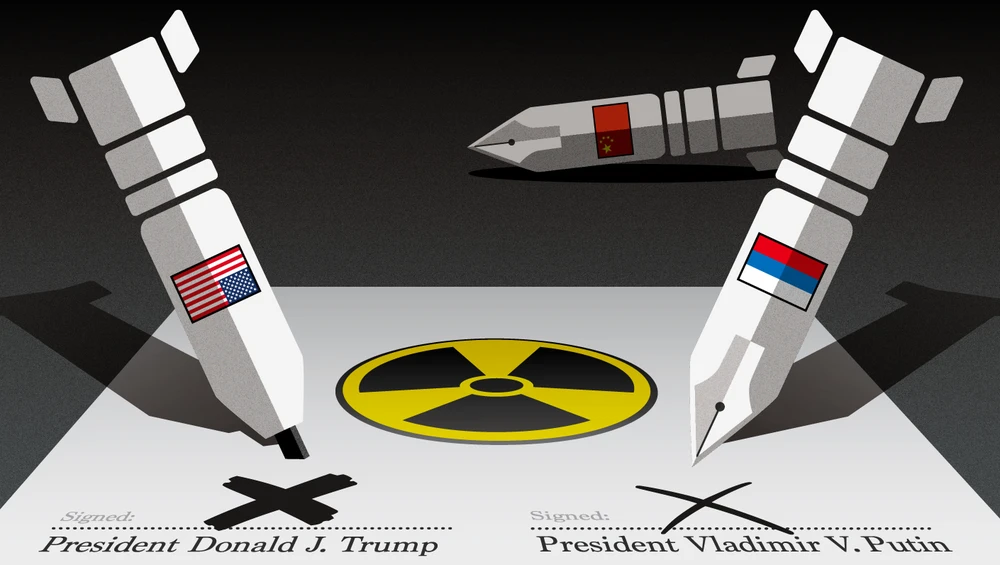
The U.S. Navy's video had little drama to draw the world's attention away from the coronavirus pandemic. In a clip uploaded to YouTube, a small missile lifts off, orange flames glowing against the black of the Hawaii night. It's over in a mere five seconds.
The unremarkable March 19 footage, however, showed another step in a rapidly accelerating arms race. What looked like an ordinary missile was in fact a hypersonic glide vehicle, a newfangled weapon that flies five times the speed of sound and changes direction midflight to evade defenses.
The successful American test came as all three powers rush to upgrade their nuclear and conventional arsenals, and as the post-Cold War arms control framework collapses. The last vestige, the 2010 U.S.-Russia treaty known as New START, expires in February 2021, removing limits on the number of strategic nuclear weapons the countries can possess and deploy.
The Donald Trump administration insists any extension should include China, which wants no part of the deal. Now some experts are warning that the end of New START, coupled with U.S. plans to place conventional intermediate-range missiles in Asia, could mark the beginning of a true China-Russia military alliance.
"The perception is that the United States is using this New START extension opportunity to impose pressure on China, and such a move is viewed as illegitimate from the Chinese perspective," said Tong Zhao, a fellow at the Carnegie-Tsinghua Center for Global Policy in Beijing.
"China believes that because the United States clearly has a much more powerful capability than China, it simply does not make sense for China to be part of a trilateral arms framework."
 China displays its DF-17 hypersonic missiles during its National Day parade in Beijing last October. © Reuters
China displays its DF-17 hypersonic missiles during its National Day parade in Beijing last October. © Reuters It is true that China has a much smaller nuclear arsenal than either the U.S. or Russia -- fewer than 300 warheads versus around 6,000 for each of its peers, including reserved and retired units, according to the latest counts from the Bulletin of the Atomic Scientists.
But it is also true that China has sought to expand and modernize that arsenal.
Just last Wednesday, the U.S. Department of State suggested China may be conducting underground nuclear tests despite having signed -- but not ratified -- the Comprehensive Nuclear Test Ban Treaty. The report cited China's "extensive" excavation activity at a testing site, "possible preparation" to use the site year-round, use of explosive containment chambers and a "lack of transparency on its nuclear testing activities."
China has not been shy about flexing its nuclear muscle. On National Day last October, it paraded the DF-41, an intercontinental ballistic missile that can deliver 10 warheads to the continental U.S., and the DF-17, a hypersonic weapon.
No less significantly, China has assembled a formidable conventional missile force over several decades. While the U.S. and Russia were bound by their 1987 Intermediate-Range Nuclear Forces Treaty -- which prohibited them from fielding any ground-launched cruise or ballistic missiles with ranges between 500 km and 5,500 km, nuclear or conventional -- China had free rein to develop such weapons.
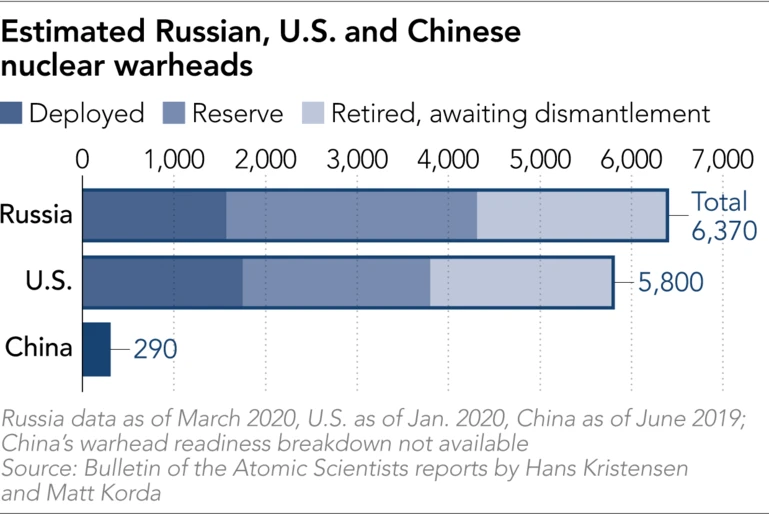
China's missile arsenal has grown to include "carrier killers" like the DF-21D and the DF-26, which can target not only aircraft carriers and other ships over 1,000 km away, but also U.S. bases as far away as Guam.
Tong said China's conventional missile buildup has at least two broad objectives. One is to secure key national interests, such as reunification with Taiwan. Another is to assert territorial claims in the South China Sea and over the Japan-administered Senkaku Islands, which Beijing calls Diaoyu.
"The biggest threat to China securing these interests comes from the U.S. capability and intention to militarily intervene in these areas," Tong said. "Land-based intermediate range missiles constitute a very effective tool for China to secure a military advantage around the first island chain and deter American military intervention," he added, referring to the first line of major archipelagos off continental East Asia.
None of this sits well with Washington.
Adm. Harry Harris, then the head of the U.S. Pacific Command, told Congress in 2017 that China "controls the largest and most diverse missile force in the world," and that 95% of it "would violate the INF Treaty if China was a signatory."
"Any moves by the United States to deploy its missiles or missile defense systems [in Asia] will fuel ever-greater cooperation between Russia and China"
Evgeny Buzhinsky, former Russian military arms control negotiatorThese concerns translated into action when the U.S. withdrew from the INF Treaty last August. While Washington blamed alleged violations by Moscow, the primary motive was to counter potential threats from Beijing, according to Elbridge Colby, a former senior Pentagon official who helped author the Trump administration's National Defense Strategy.
"The Chinese aspect to this is far more important for the United States," Colby said.
"Although it could be beneficial for the United States to have INF Treaty missiles in Europe, especially some shorter-range variants that cannot penetrate deep into Russia, it is far more important and necessary to have them in the Pacific because of the scale of China's military buildup and the geography of the region."
Colby explained that since most American assets in the western Pacific are concentrated on a few bases and ships, placing ground-launched conventional missiles in the region would significantly increase the number of targets China must account for.
Just days after the U.S. withdrew from the INF Treaty, Defense Secretary Mark Esper announced that such missiles would be coming to Asia "sooner rather than later." The Chinese foreign ministry shot back that Beijing "will not stand idly by and will be forced to take countermeasures" if the U.S. deploys them.
Undeterred, the U.S. Indo-Pacific Command late last month submitted a budget to Congress that requests over $20 billion in additional funding to "regain the advantage" in the region. This includes money for intermediate-range weapons such as the Navy's Tomahawk cruise missiles, which can be fired from land or sea.
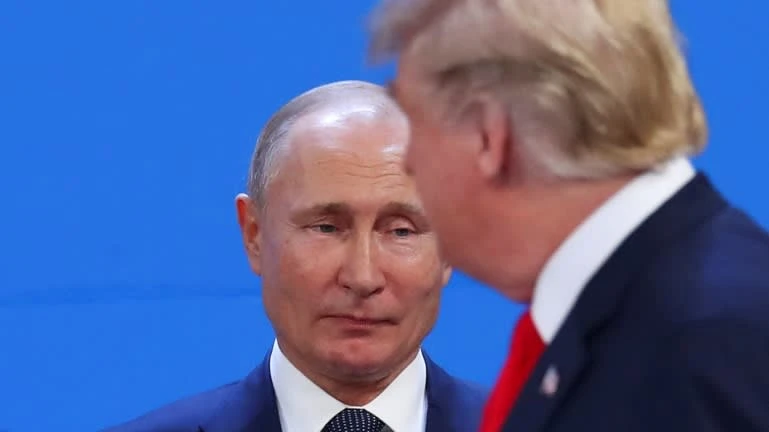 Russian President Vladimir Putin and U.S. President Donald Trump do not see eye to eye on the inclusion of China in a renewed New START. © Reuters
Russian President Vladimir Putin and U.S. President Donald Trump do not see eye to eye on the inclusion of China in a renewed New START. © Reuters China would not be alone in pushing back if the U.S. installs INF Treaty missiles in Asia, said Evgeny Buzhinsky, a retired lieutenant general who served as the Russian military's top arms control negotiator.
He told the Nikkei Asian Review that Moscow may respond by deploying its own intermediate-range, land-based missiles in the Russian Far East.
"If the Americans place these missiles in Guam or the Philippines, then fine, let them do so," Buzhinsky said. "But if they place them in Japan, then that will be a threat to Russia and we will place our missiles somewhere in Chukotka so that they could reach U.S. territory."
Some Russian experts go even further, predicting that a U.S. missile deployment in Asia would prompt Russia and China to abandon longstanding reservations about a formal military alliance.
"If the Americans will commit the stupidity of deploying missiles in East Asia in a way that is threatening to both Russia and China, then our relationship [with China] will effectively cross a certain line and become a military alliance," said Alexey Arbatov, head of the Center for International Security at the Institute of World Economy and International Relations in Moscow.
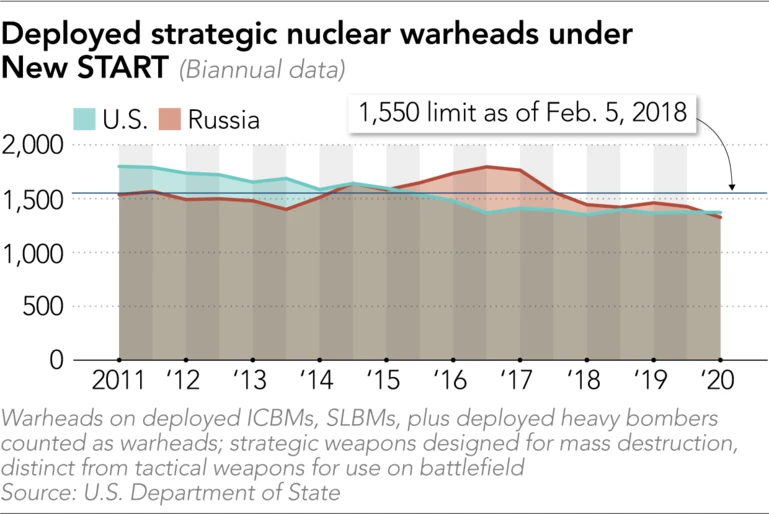
U.S. moves have already nudged Russia and China closer together. In October, Russian President Vladimir Putin revealed Moscow was helping China to develop an early warning system for missile attacks. Only the U.S. and Russia possess such systems.
Buzhinsky, who retired from the Russian Armed Forces in 2009, said assisting China with this would have been unthinkable a decade ago.
"I remember when I was in the Ministry of Defense, we made every possible effort to avoid this issue because it is a very sensitive area for cooperation," Buzhinsky said. "That we are now helping China develop this system is a huge step forward and it shows that any moves by the United States to deploy its missiles or missile defense systems [in Asia] will fuel ever-greater cooperation between Russia and China."
The looming demise of New START could lead to even more drastic steps by Moscow.
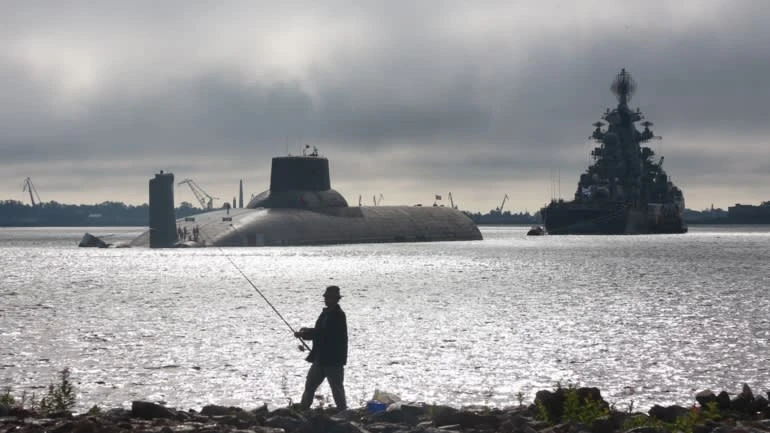 A Russian nuclear ballistic missile submarine arrives in St. Petersburg for a parade in 2017. © Getty Images
A Russian nuclear ballistic missile submarine arrives in St. Petersburg for a parade in 2017. © Getty Images Arbatov warned that if the U.S. does not agree to renew the deal, Russia could go so far as to offer China strategic ballistic missiles and bombers. "Strategic" weapons are considered distinct from "tactical" ones, in that they are designed for mass destruction as part of a broad military strategy rather than for use on a battlefield.
The coronavirus has only further clouded the prospects for saving New START in the coming months. Russia's TASS state news agency reported that the pandemic has interrupted the regular bilateral inspections stipulated in the deal.
Moscow has also criticized Washington's call to rope China into the treaty.
"It's an open provocation to insist on China's participation in the process, as a precondition, despite Beijing's clearly stated and many times repeated position on this," Russian Foreign Minister Sergei Lavrov declared at a nonproliferation conference in Moscow last November.
Yet last Friday, U.S. Secretary of State Mike Pompeo spoke to Lavrov by phone and "emphasized that any future arms control talks must be based on President Trump's vision for a trilateral arms control agreement that includes both Russia and China," a State Department spokesman said.
If Cold War history is any guide, Buzhinsky argued, tensions in Asia are likely to get much worse before they get better.
"The Cuban Missile Crisis was what brought about the modern era of arms control," he said. "It will probably take another crisis for everyone to realize that it is necessary to talk and reach a deal."




















